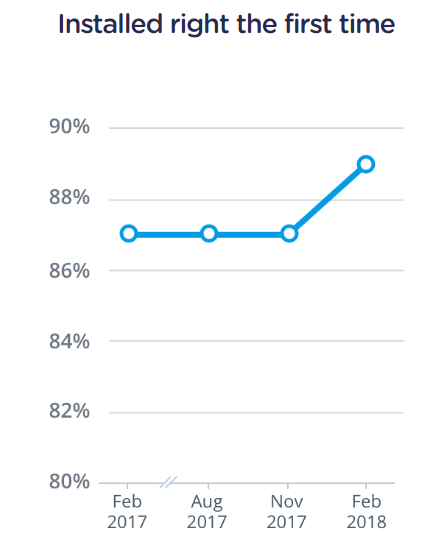NBN says individual lines have 1 percent chance of failure

The company responsible for deploying the National Broadband Network across Australia has released a collection of statistics showing what a bang up job it has done in the past three months, because if these numbers saw the light of day in November, it would paint a much bleaker picture.
The new dashboard shows that over the past year, individual lines on the network have consistently had a 1 percent failure rate -- starting at 0.9 percent, or 0.9 faults per 100 connections, in February 2017, peaking at 1.2 percent in November, before falling to 1 percent for last month.
"This measure tracks individual service faults, not network related faults which are tracked separately," NBN said.

NBN shows how to make a 2 percentage point increase look like a ski jump.
For the network availability metric, the company has fallen from 100 percent uptime last year, to 99.9 percent this year, which could potentially translate to around 44 minutes of downtime each month.
On its fixed network, the company claimed less than 0.2 percent of its connections experienced access network congestion, and the average bandwidth congestion on its network, excluding satellite connections, has been reduced to 12 minutes. Previously, its average bandwidth congestion clocked in at four hours and 50 minutes in February 2017, four hours and 57 minutes for August, and three hours and 51 minutes in November.
In the last three-month period, NBN has seen an uptick in the number of users on plans providing 50Mbps or greater speeds, now sitting at 25 percent after being stagnant on 16 percent.
The company announced at the end of last year it would offer discounts on its 50Mbps and 100Mbps speed tiers. Its 50Mbps wholesale bundle now costs retail service providers AU$45 per month -- a 27 percent discount on its previous pricing -- and include 2Mbps of bandwidth, while the 100Mbps wholesale bundle was reduced by 10 percent to cost AU$65 for 2.5Mbps of included capacity.
"Combining access and bandwidth charges into one simple price point will not only promote the take-up of plans based on higher wholesale speed tiers and position the NBN 50 bundle as our flagship service, but it will also trigger the triple benefit of improved end user experiences, provide more affordable pricing options for retailers, and support NBN Co's revenues in the longer term," NBN CEO Bill Morrow said at the time.
Despite exaggerating its improvement in a misleading graph, NBN did report that the number of installations to occur correctly the first time improved by 2 percentage points between November and February, while the number of premises connected within agreed timeframes continued to sit at 92 percent.
Perhaps the most improved metric has been the time within which NBN fixes faults as agreed with its retailers, rising from 72 percent a year ago, to 85 percent in February. In November, one in five faults fell outside the agreed time to fix.
Related Coverage
NBN migration plan modified for FttC connections
After feedback, connections will not be deemed active until end-user traffic is detected.
ACCC to review backhaul declaration
Consumer watchdog to examine whether its Domestic Transmission Capacity Service declaration is still needed.
Want the best chance of a fibre NBN connection? Move to croc country
In percentage terms, the mainland territories provide the best opportunity to get on the 'real' NBN.
Qantas adding in-flight Wi-Fi to one aircraft per week
More than 30 percent of Qantas' domestic fleet has been fitted out with on-board Wi-Fi connectivity at a rate of around one aircraft per week, the airline has revealed.
5G mobile networks: A cheat sheet (TechRepublic)
As LTE networks become increasingly saturated, mobile network operators are planning for the 5G future. Here is what business professionals and mobile users need to know about 5G.